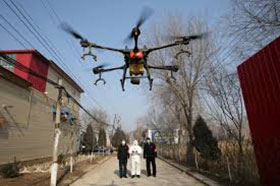

Since the World Health Organisation moved to declare COVID-19 a pandemic in early March, public health experts around the world have advocated for self-isolation as a way to reduce the spread of the disease and ‘flatten the curve’. As more individuals stay home to reduce their risk of infection, drones are emerging as powerful tools, both helping prevent infections, and ensuring that life continues during the pandemic.
In countries hardest hit by the pandemic, drones have emerged as tools for authorities to communicate with citizens. In China, drones have been seen carrying signs with QR codes, allowing citizens to use mobile phones to register for support without requiring human contact and reducing the possibility of virus transmission. In Italy, drones with speakers attached have allowed police officers to communicate with citizens on the streets to remind them of self-isolation practice without the risk of transmission.
UAS (unmanned aircraft systems) tech is also proving to be useful for disinfecting public spaces and epidemic prevention vehicles, through the use of remotely operated spray drones. “Compared with hand spray, drone spray has many advantages in terms of efficiency and consistency," noted Justin Gong, co-founder of China-based drone company XAG. Chinese companies are also buying disinfection robots, to help fight infections within hospital environments.
Drones have proven so useful throughout the crisis that Shenzhen-based DJI has created a US$10 million RMB fund to fight the coronavirus by funding drone-enabled disinfection and protocols. Meanwhile, XAG set up a US$50 million RMB fund to use drones for disinfection in remote areas.
Medical sample delivery is yet another example of how #TechForGood is supporting the pandemic response. Drone delivery is often demonstrably faster than human delivery, and reduces the risk of drivers being exposed to possible infection. “At the moment of life and death, the air transport network can significantly confine the flow of people, avoid unnecessary physical contact and prevent secondary transmission,” said Lv Yinxiang, Secretary of the Party Committee of the County People’s Hospital. “Medical samples delivered through air can shrink the delivery time while saving precious field resources.”
The past few weeks have seen coronavirus-induced drops in stock markets around the world. Much of this speculative panic relates to the potential impact of coronavirus on labour forces which could be devastated by the outbreak. In China, a country heavily dependent on labour to support its agricultural sector, sales of agricultural drones have reportedly skyrocketed. CNBC reports that XAG alone has delivered more than 4000 agricultural drones this year. The Chinese government is further distributing subsidies for automated agricultural tech, which could help sustain the industry in the face of further self-isolation and a weakened labour force.
While there is little clarity on the impact COVID-19 will have on the world, it seems a fair assumption that drones will remain increasingly valuable for supporting public health and resisting its effects.

© Technews Publishing (Pty) Ltd | All Rights Reserved